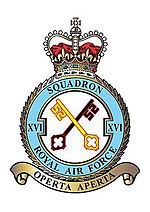No. 16 Squadron RAF
| No. 16 (Reserve) Squadron RAF | |
|---|---|
 |
|
| Active | 10 February 1915 – Present |
| Role | Elementary Flying Training |
| Garrison/HQ | RAF Wittering |
| Motto(s) |
Operta aperta, (Hidden things are revealed) |
| Equipment | Grob Tutor |
| Battle honours | Western Front 1915–1918, Neuve Chapelle, Loos, Somme 1916, Arras, Ypres 1917, France and Low Countries 1940, Dunkirk, Fortress Europe 1943–1944, France and Germany 1944, Normandy 1944, Arnham, Ruhr 1944–1945, Gulf 1991 |
| Insignia | |
| Squadron Badge | Two keys in saltire. The badge symbolises army co-operation duties. The keys indicate the unlocking of the enemy's secrets; the gold key by day, the black key by night. |
| Squadron Roundel | |
No. 16 (Reserve) Squadron is a flying squadron of the Royal Air Force. It formed in 1915 at Saint-Omer to carry out a mixture of offensive patrolling and reconnaissance and was disbanded in 1919 with the end of the First World War. The squadron reformed on 1 April 1924 and again took on a reconnaissance role which it continued throughout the Second World War.
Post-war, the squadron was disbanded and reformed several times and was converted to a bomber squadron. Equipped with the Tornado GR.1 from 1984 the squadron took part in the Gulf War in 1990. It was again disbanded in September 1991, before reforming in November 1991 as the Operational Conversion Unit for the Jaguar. With the Jaguar's imminent withdrawal from service, the squadron disbanded once more in 2005.
16 Squadron reformed again and took on its current role on 1 October 2008. Based at RAF Wittering, it instructs pilots in elementary flying using the Tutor.
The Squadron was formed at Saint-Omer, France on 10 February 1915 from elements of Nos. 2, 6 and 9 Squadrons. It immediately began fighting in the First World War under Hugh Dowding. In September 1915 the author Duncan Grinell-Milne joined the squadron as a junior pilot. In 1933 he published an account of his time in the squadron. His portrait of Dowding (who when the book was originally published had not then attained his later fame) is by no means a flattering one. For the rest of the Great War, the 'Saints' were deployed throughout Northern France and operated a mixture of aircraft including Bleriot XI, Martinsyde S.1 and Royal Aircraft Factory B.E.2c on offensive patrol and tactical reconnaissance duties. Disbandment occurred on New Year's Eve 1919 followed by reformation at Old Sarum on 1 April 1924. Initially the Bristol Fighter was operated in the tactical reconnaissance role and this was followed by the Atlas and Audax.
...
Wikipedia
